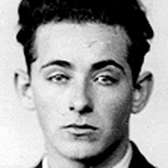
-
Learn More about Marty
- Collections View Marty's papers
- Echoes of Memory Read Marty's writings
- First Person Watch Marty share his Holocaust experiences at a First Person program
- Oral History Access Marty's Oral Testimony
- Podcast Hear Marty discuss his liberation from Gunskirchen, a subcamp of Mauthausen, in 1945
Martin “Marty” Weiss was born Meier Weiss on January 28, 1929 in Veľká Poľana, Czechoslovakia to Jacob and Golda Weiss. Jacob was a subsistence farmer and a meat distributor, and Golda managed their orthodox Jewish household and raised their nine children (Mendl, Issac, Ellen, Cilia, Moshe, Hannah, Marty, Esther, and Monica). Czechoslovakia had become an independent democracy after World War I, and the Weiss family were proud citizens of the newly-formed nation.
In 1938-1939, Nazi Germany and other countries dismantled Czechoslovakia and annexed and occupied much of its territory. Hungary took control of the southeastern part of Slovakia, where Marty and his family lived. The Hungarians implemented antisemitic laws, which were similar to the Nuremberg Race Laws and defined Jews in Hungary racially. Jews in Hungary lost their equal rights as citizens, and economic opportunities for Jews were restricted. The Hungarian regime also required Jewish men, including Marty’s two oldest brothers, Mendl and Issac, to serve in forced labor battalions. Beginning in 1941, tens of thousands of Jewish men were sent to the eastern front, where the vast majority died from dangerous and deadly conditions. Although the rights of Jews to engage in trade and own businesses were heavily restricted, Jacob managed to retain his business license. He continued to earn money by performing ritual slaughter on animals, which had been banned by the government, at night and selling the meat on the black market.
In March 1944, Nazi Germany occupied its ally Hungary and enacted even more restrictive antisemitic measures, including requiring Jews to wear the yellow star badge on their clothing. Beginning in April 1944, Germans and their Hungarian collaborators forced hundreds of thousands of Hungarian Jews into ghettos. The Weisses were imprisoned in the Munkács ghetto for several weeks. In the ghetto, the Hungarian guards forced the Weisses and others to move bricks by hand from one side of the factory to the other and back again. This pointless but grueling task was an act of torture and humiliation. Over a two-month period beginning in May 1944, nearly 440,000 Jews were deported from Hungary. Most were sent to Auschwitz-Birkenau killing center, including Marty and most of his family who were deported to Auschwitz in May 1944. When they arrived, the transport underwent a selection process, in which a small percentage of people were selected for forced labor. Marty, his brother Moshe, his sisters Cilia and Hannah, their father Jacob, and two uncles were selected for forced labor. The Nazi-SS murdered his mother Golda and two younger sisters Esther and Monica in gas chambers, along with other extended family members.
Marty and Jacob were then transported to the Mauthausen concentration camp, where they were forced to work in the stone quarries, and then to Melk, a subcamp of Mauthausen. In Melk, the Germans forced prisoners to carve tunnels into the sides of mountains. Jacob died from exhaustion and starvation. As the Allies advanced into Germany in the spring of 1945, the Nazi-SS evacuated the Melk camp. Marty and other inmates were sent back to the main camp. Marty was then forced on a death march from Mauthausen to Gunskirchen, a Mauthausen subcamp located in a forest with extremely primitive and overcrowded conditions. He was liberated at Gunskirchen by the United States Army on May 5, 1945.
After liberation, Marty returned to Czechoslovakia. There he reunited with Cilia who was liberated by the British at Bergen-Belsen in April 1945. He learned from Cilia that their sister Hannah had died in the camps. Cilia married fellow survivor Fred Moss. He also reunited with his oldest brother, Mendl, who had survived the war in a Hungarian labor battalion. The siblings located their sister Ellen who had immigrated to the United States in 1939. Ellen helped secure United States immigration visas for Marty, Mendl, Cilia, and Fred, and they arrived in New York in July 1946. They later learned the fate of their other brothers. Issac had survived his service in the Hungarian labor battalions. Moshe had survived the camps, but died shortly after liberation under unclear circumstances. Of the eleven members of Marty’s immediate family, five survived the Holocaust.
Marty served in the United States Army during the Korean War before entering the grocery business in 1955. In 1957 he married Joan Merlis. They have two children. Marty volunteered at the United States Holocaust Memorial Museum.
